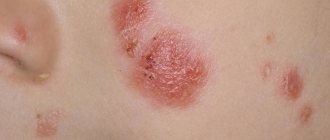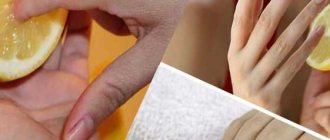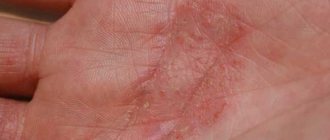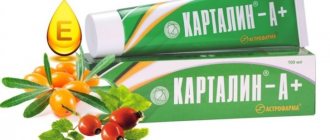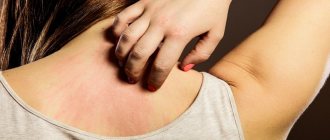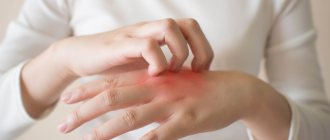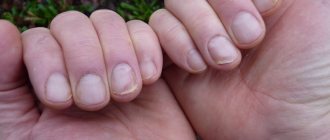Pustular psoriasis is a severe form of pathology that is relatively rare. In more than half of cases, this form of the disease develops against the background of ordinary vulgar psoriasis. The generalized spread of rashes in pustular psoriasis leads to severe symptoms of intoxication, increases the likelihood of a secondary infection and requires effective and early therapy.
Symptoms of pustular psoriasis
The pustular form of psoriasis is characterized by inflamed red skin that is raised and thickened. Above it are pustules - bubbles with a yellowish liquid.
If the disease is advanced and there is no proper treatment, fever and general malaise may occur.
There are also different types of pustular psoriasis.
Psoriasis of the palms and soles of Barbera
Pustular rashes with this type are most often located under the big toe and on the little toes, on the arch of the foot.
The plaques are sharply defined, bubbles with liquid are located on their surface, as well as on other places of the skin.
Generalized Tsumbusch psoriasis
The most severe type of pustular psoriasis occurs with malaise and fever. Pinpoint painful pustules appear against the background of bright red spots.
Spots of generalized psoriasis of Tsumbusha
Foci of the disease quickly grow and merge, forming “purulent lakes.” The skin in these places peels off.
Nails, joints, and sometimes kidneys are often affected. Blood tests of patients with such pustular psoriasis determine an excess of white blood cells (leukocytosis).
The patient's condition improves and the temperature drops after new pustules stop appearing. However, a new attack develops unpredictably and suddenly.
Persistent purulent acrodermatitis Allopo
Rashes with pus with this type appear on the phalanges of the fingers. The nail plates change, the phalanges of the fingers thicken. On the affected areas, red spots, swelling, and purulent blisters are visible, which merge into “purulent lakes.”
Purulent acrodermatitis Allopo
Diagnostics
If changes appear on the skin, you should first consult a dermatologist. The doctor makes a diagnosis based on examination, questioning of the patient, and research data. As with the vulgar form of psoriasis, the pustular variant of the course of the pathology corresponds to a specific triad of symptoms:
- “Blood dew” - a slight mechanical impact on the stain leads to the appearance of small droplets of blood on its surface;
- Stearic stain - scraping the rash leads to the separation of easily removable scales;
- Terminal film - after removing the scales, a reddish shiny spot appears.
Laboratory diagnostics:
- General and biochemical blood test, urine test. These tests help identify concomitant diseases;
- Tests for rheumatoid factor;
- Tests for antibodies to HIV.
The symptoms of pustular psoriasis are similar to other dermatological pathologies. Therefore, during diagnosis, it is necessary to differentiate the disease from atopic dermatitis, parapsoriasis, seborrheic skin lesions, lichen (lichen planus), papular syphilide.
Causes of pustular psoriasis
The following factors contribute to the occurrence of this type of psoriasis:
- Infectious diseases, especially streptococcal ones.
- Hormonal imbalances (including those caused by oral contraceptives).
- Severe stress.
- Incorrect external therapy for skin diseases.
- Abrupt withdrawal of corticosteroids and immunosuppressive drugs.
Regardless of the reasons, a doctor should prescribe therapy and monitor recovery . Pustular psoriasis is a severe form; self-medication here is life-threatening and can lead to disability.
Let's look at the types of therapy that modern medicine uses.
Why does it arise?
The causes of pustular psoriasis are not precisely understood. The main symptom of the disease is disturbances in the division of skin cells, resulting in scaly and papular elements of the rash. The trigger mechanism can be various factors:
- endocrinological disorders;
- severe stress;
- prolonged exposure to open sun;
- postpartum period;
- reduced immunity;
- constant trauma to the skin;
- hereditary factor.
To choose the right course of treatment, it is important to find out which factor served as the trigger for the development of the disease.
Interesting! Pustular psoriasis can mutate from vulgar psoriasis due to long-term use of aggressive cytostatics and self-medication. Therefore, the sooner the patient seeks help from a specialist, the more effective the therapy will be.
Treatment of pustular psoriasis
The pustular form of psoriasis is the basis for hospitalization of the patient. Treatment is carried out comprehensively, in a hospital or sanatorium.
Drugs for the treatment of pustular psoriasis
All drugs are used only under the supervision of a physician. For pustular psoriasis, the following is taken orally for treatment:
Methotrexate
- detoxification drugs (saline solution, reamberin)
- antipyretic drugs;
- corticosteroids (prednisolone, dirospan);
- antihistamines;
- synthetic analogues of vitamin A (tigazon is the most effective);
- antimetabolites (metatrexate, mercatopurine);
To further treat the pustule, the doctor pricks it with a sterile needle. Then external preparations are used:
- aniline dyes;
- Polcortolon TS;
- potent corticosteroid creams (Dermovate);
- zinc ointment with hydrocortisone;
- synthetic analogues of vitamins A and D3.
Phototherapy for pustular psoriasis
Phototherapy is indicated only for stable disease and cannot be used during exacerbation. For pustular psoriasis, PUVA therapy and sometimes ultraviolet 311 nm are used.
PUVA therapy cabin
PUVA therapy is a method that combines medications and long-wave ultraviolet rays. First, the patient is given medicine, then irradiated in a special cabin. When treated with this method, psoralens are taken - substances that increase susceptibility to ultraviolet radiation.
Re-PUVA therapy differs from PUVA only in the medications. When treated with this method, retinoids (vitamin A analogues) are taken. These substances also improve ultraviolet sensitivity in psoriasis patients.
Spa treatment
Sanatorium Poltava (Crimea) for the treatment of psoriasis
In a stable stage of the disease and in remission, patients with pustular psoriasis are sent to sanatoriums - in Pyatigorsk, Sochi, etc.
In such institutions, conditions are organized for the prevention and treatment of psoriasis: psychological assistance, relaxing and restorative activities.
How to treat palmoplantar psoriasis at home?
The main goal of therapy is to improve the general condition of the patient, weaken the manifestations of the disease and accelerate the onset of the remission process. For this purpose, a whole range of medications and accompanying therapeutic measures are used.
Creams and ointments for hands and feet
Local application of creams and ointments helps eliminate inflammation and quickly restore the healthy appearance of the skin.
To obtain an accelerated effect, hormonal compounds are used:
- Hydrocortisone;
- Fluorocort;
- Flucinar;
- Akriderm;
- a lot others.
At earlier stages, as well as for preventive purposes, it is possible to use non-hormonal formulations: baby cream, ointments based on aloe, celandine or elecampane, keratolytics and others.
Hormonal medications are addictive, so the duration of their use and intensity should be determined by the attending physician.
Treatment with oral drugs
To achieve the desired effect, a complex of oral medications is used. These include:
- anti-inflammatory drugs (Methotrexate, Diprospan and others);
- sedatives (Persen Forte and others);
- antihistamines (Suprastin, Cetril);
- vitamin complexes;
- enterosorbents (Enterosgel).
The dosage and duration of use of any of the listed drugs is prescribed by the attending physician, based on the patient’s well-being.
Diet therapy
Diet is the main component of antipsoriasis therapy. Properly selected food products and the exclusion of harmful dishes will help the body quickly restore strength and direct it to eliminate pathology.
Following a diet can also be an excellent prevention of relapses and the development of complications of the disease.
In order not to provoke a recurrence of unpleasant symptoms, it is necessary to exclude salty, spicy, spicy, fatty, fried, smoked foods from the diet . You should also give up confectionery, coffee, and strong tea.
The patient's diet should be balanced and consist of healthy foods: various types of cereals, lean meats and fish, vegetables, fruits, simple baked goods, herbal or weak teas.
It is better for people with psoriatic manifestations to avoid alcohol and smoking.
The best folk remedies
Using “grandmother’s” recipes can have a positive effect. But before using them, be sure to consult your doctor. You can find many versions of folk recipes on the Internet.
Let's present only the most popular recipes:
- mix 3/5 of the string root, 1/5 each of valerian and celandine root, 1 tbsp. marshmallow root. Pour a glass of boiling water over everything, let it brew and drink throughout the day before meals;
- prepare a warm bath by dissolving 1.5 kg of salt in water. Soak in the bath for 20 minutes. The procedure is carried out before bedtime;
- Before meals, take 2-3 propolis tablets three times a day.
You can also find other recipes that are best suited for you.
Modern methods of physiotherapy to help cure the disease
To enhance the effect of medications, specialists resort to the use of physiotherapeutic procedures.
Today patients are prescribed:
- ultraviolet irradiation;
- PUVA therapy;
- various types of UV therapy;
- UVB of blood.
It is also possible to use some other physiotherapeutic manipulations.
conclusions
Pustular psoriasis is a severe form of the disease that requires examination by a doctor.
Symptoms:
- red, inflamed spots with blisters (pustules);
- sometimes their localization is only on the palms and feet, sometimes on other parts of the body;
- fever, high temperature, malaise.
Pustular psoriasis can occur due to infections, improper external treatment, and withdrawal of corticosteroid medications.
Treatment is carried out only by a doctor. For internal therapy use:
- antipyretic drugs;
- corticosteroids;
- vitamin A analogues and others.
Effective in external therapy:
- zinc ointment with hydrocortisone;
- corticosteroid creams;
- ointments with analogues of vitamins A, D3.
In case of a stable course of the disease, PUVA therapy, Re-PUVA therapy, and ultraviolet irradiation at 311 nm are used. Sanatorium-resort treatment (Sochi, Pyatigorsk)
also gives results
Complications and consequences
The disease does not pose a threat to others, that is, psoriasis is absolutely not contagious. In a patient, pathology can cause exacerbation of chronic diseases, the development of endocrine pathologies, and dysfunction of the heart and nervous system. The pustular form of lichen squamosus is severe and often with the following complications:
- pyoderma - purulent inflammation of the skin due to infection of opened pustules with pyogenic microorganisms;
- onycholysis - separation of nails from underlying tissues;
- alopecia - complete or partial baldness;
- psoriatic arthritis;
- sepsis - in the absence of treatment for the generalized form of the disease;
- hypoalbuminemia - a decrease in the level of albumin protein in the blood, which is manifested by generalized edema;
- hypocalcemia - low level of calcium in the blood, which is manifested by hemorrhagic syndrome, cramps of various muscle groups, heart rhythm disturbances, degenerative tissue changes;
- oligemia (decrease in the total amount of blood) and, as a consequence, liver failure and necrotizing papillitis (necrosis of the renal papillae) or necrosis of the renal tubules;
- malabsorption is a violation of the absorption of nutrients in the intestines, manifested by prolonged diarrhea, anemia, and weight loss.
The best remedies for Psoriasis
Add to cart
Antipsoriasis cream 990 rub.
Add to cart
Magnipsor ointment RUB 1,490
Add to cart
Ultraviolet lamp Dermalight ® RUB 14,900.
Diet correction
Diet plays an important role. The following products are recommended to the patient:
- grain bread;
- fruits and vegetables;
- lean varieties of fish and meat;
- beans and other legumes;
- dairy products;
- porridge.
It is best to steam food and divide it into small portions for consumption, adhering to the “little and often” principle. Good nutrition will improve digestion, increase immunity and reduce the manifestations of the disease.
It is impossible to completely get rid of psoriasis, but prolonging remission is a feasible task. By following the doctor's recommendations, patients can lead an active life. In some cases, remission can last for many years.
Prevention
Since the exact causes of the disease are unknown, and the mechanisms are not fully understood, there are currently no specific methods for preventing the pathology. The risk of its development can be reduced by following these recommendations:
limiting alcohol consumption (or better yet, refusing to take it);- preventive measures aimed at preventing the development of infectious processes, and if they have already arisen, timely recognition and treatment;
- taking medications only as prescribed by a doctor and under his supervision;
- avoiding injury to the skin;
- avoiding staying in unfavorable environmental conditions; if living in it, change your place of residence.
Total information
Generalized pustular psoriasis (or Zumbusch's disease) belongs to the category of chronic relapsing immune-mediated dermatoses. It is characterized by a severe course and poses a danger to human health and life.
The first mention of this disease is in the works of Hippocrates, which have survived to this day. In those days, psoriasis was known under the names “leprosy,” “psora,” and “lichen.” Pustular psoriasis was first described only in 1910. This was done by the Austrian dermatologist Zumbusch, which is why the disease is also called Zumbusch syndrome - this name is still found in old textbooks on dermatology.
Its pustular form differs from vulgar psoriasis, which accounts for about 3% of all dermatological pathologies, in that it is diagnosed much less frequently. Although there is an opinion that the incidence is low, since such patients often die.
Men and women get sick with approximately the same frequency.
note
This disease can appear at any age, but is most often first diagnosed during puberty.
Generalized pustular psoriasis is a pathology that can be fatal, so its problem is always relevant in dermatology.

